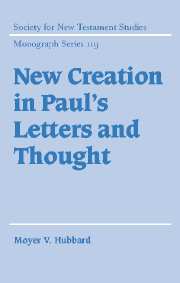Book contents
- Frontmatter
- Contents
- Acknowledgments
- List of abbreviations
- 1 Introduction: the current debate
- PART I NEW CREATION: CENTRAL JEWISH TEXTS
- Part II FROM DEATH TO LIFE: NEW CREATION IN THE CONTOURS OF PAUL'S THOUGHT
- Part III THE OLD AND THE NEW: NEW CREATION IN THE CONTEXT OF PAUL'S LETTERS
- References
- Index of passages cited
- Index of modern authors
Part III - THE OLD AND THE NEW: NEW CREATION IN THE CONTEXT OF PAUL'S LETTERS
Published online by Cambridge University Press: 02 December 2009
- Frontmatter
- Contents
- Acknowledgments
- List of abbreviations
- 1 Introduction: the current debate
- PART I NEW CREATION: CENTRAL JEWISH TEXTS
- Part II FROM DEATH TO LIFE: NEW CREATION IN THE CONTOURS OF PAUL'S THOUGHT
- Part III THE OLD AND THE NEW: NEW CREATION IN THE CONTEXT OF PAUL'S LETTERS
- References
- Index of passages cited
- Index of modern authors
Summary
2 Corinthians 5.16 and 17 have been ranked among “the most famous verses in the whole of the New Testament“, and there is no reason to dispute this claim. Yet familiarity is both friend and foe of good exegesis. Carol Stockhausen lists 2 Corinthians 5.16–21 as one of a small handful of passages in this letter which have come under intense scholarly scrutiny, yet which are all too often examined, “without regard for their function within 2 Corinthians itself.” In a similar way, Jörg Baumgarten laments the fact that so much exegesis of Galatians 6.15 and 2 Corinthians 5.17 has been led astray (verleiten) by the history-of-religions parallels to Paul's καιν κτσις motif rather than “in erster Linie dem Kontext die Funktion der Deutung zugestehen.”
The point made by these authors is legitimate, and in what follows I will take up their challenge and locate Paul's new-creation statements in the argument of the letters in which they are found. Good exegesis is often a delicate balance between the literary context of an idea and the larger conceptual world of which it is also a part. However, when several historical-conceptual backgrounds are on offer, the determinative vote should be cast by the specific literary-theological context. As we shall see, careful attention to the argument of 2 Corinthians and Galatians – along with the historical circumstances which prompted these letters – provides all the necessary clues to the interpretive riddles of these passages, be it what some have called “cosmic crucifixion” (Gal. 6.15), or knowing Christ κατ$ σ%ρκα (2 Cor. 5.16).
In placing Paul's new-creation statements in their epistolary context, we immediately face the question of which letter to consider first.
- Type
- Chapter
- Information
- New Creation in Paul's Letters and Thought , pp. 131 - 132Publisher: Cambridge University PressPrint publication year: 2002

